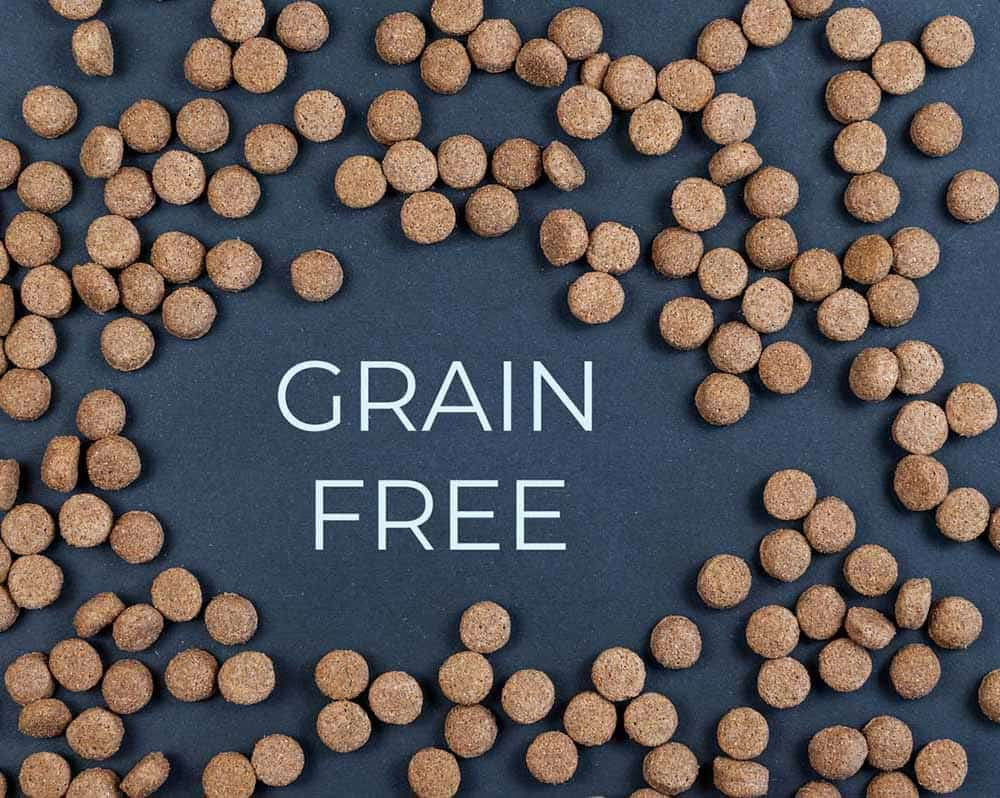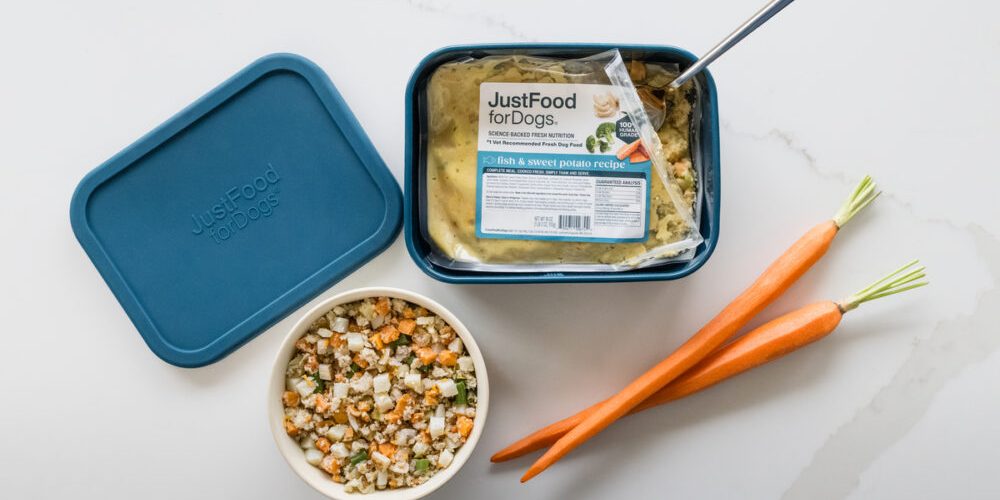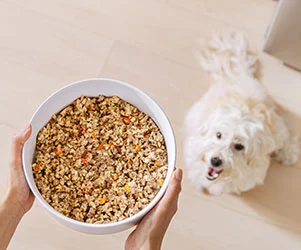TL;DR: Grain-Inclusive vs. Grain-Free Dog Food
-
Grain-free diets aren’t always healthier. They rose in popularity by comparing dogs to wolves and labeling grains as “fillers,” but research doesn’t support that claim.
-
FDA investigations linked some grain-free “BEG” diets (boutique, exotic, grain-free) to heart disease (DCM) due to nutrient imbalances.
-
Dogs are omnivores, not wolves. They’ve evolved to digest grains efficiently, gaining energy, fiber, and essential vitamins and minerals from them.
-
Grains provide real benefits:
-
Steady energy from complex carbs
-
Digestive support through fiber
-
Nutrients like B vitamins, magnesium, and selenium
-
-
True grain allergies are rare. Most food sensitivities stem from animal proteins, not grains. Always confirm with your vet before going grain-free.
-
Grain-inclusive diets are best for most dogs, offering safe, balanced nutrition backed by science.
Bottom line: Skip the fad. Feed the facts. Choose a grain-inclusive, vet-formulated diet for your dog’s long-term health and happiness.
Choosing the right food for your dog can feel like a monumental task. Every aisle is packed with options, and advertising campaigns often push us toward the latest trend. For years, the grain-free movement has dominated the pet food conversation, leaving many well-meaning dog owners wondering if grains are the enemy of canine health. For many pups, however, grain-inclusive dog food isn’t just good, it’s often better.
As a devoted dog owner, you want to make informed decisions, not just follow fads. You’re here because you want to understand the real differences between grain-inclusive and grain-free diets, cut through the noise, and ultimately, give your furry companion the best possible nutrition. Let’s dive in.
The Grain-Free Dog Food Trend: A Journey Through Misinformation

Remember when gluten-free everything swept the human diet scene? Well, a similar wave hit the pet food world, ushering in the era of grain-free dry dog food. It was marketed as a more “natural” or “ancestral” diet, appealing to our desire to give our pets the best without fully understanding the underlying science.
The Rise of Grain-Free Diets
The grain-free trend gained immense popularity by playing on a common misconception: that dogs are essentially wolves and, therefore, shouldn’t consume grains. The narrative suggested that grains were “fillers” or common allergens, leading to digestive issues, skin problems, and a host of other ailments. Pet food companies capitalized on this, creating a vast market for grain-free kibbles, wet foods, and treats.
The messaging was powerful and persuasive, leading many to believe that eliminating grains was a surefire way to improve their dog’s health. While well-intentioned and fueled by love for our pets, it often lacked a solid scientific foundation.
The Real Science: What Recent Research Tells Us
Here’s where the plot thickens. While the grain-free trend was soaring, veterinary nutritionists and researchers began to notice a disturbing pattern. In the late 2010s, the U.S. Food and Drug Administration (FDA) started investigating a potential link between certain “boutique,” “grain-free,” and “exotic ingredient” (BEG) diets and an increased risk of dilated cardiomyopathy (DCM) in dogs.
DCM is a serious heart disease that causes the heart to enlarge and lose its ability to pump blood effectively, often leading to heart failure. What researchers found was startling: dogs on these BEG diets, particularly grain-free ones, were developing DCM at higher rates, even small breeds or large breeds not typically predisposed to the condition.
The working hypothesis points to an imbalance in certain nutrients, specifically taurine, which is crucial for heart health. While the exact mechanism is still being studied, it’s believed that the ingredients used as grain alternatives (like peas, lentils, and potatoes) might interfere with taurine metabolism or absorption, or simply not provide sufficient levels.
Decoding Your Dog’s Dietary Needs: Grains vs. No Grains

Before we dive deeper into why wholesome grains are beneficial, let’s clarify what we’re talking about and why they’re not the dietary villains they’ve been portrayed to be.
What Exactly Are Grains in Dog Food?
When we talk about grains in dog food, we’re referring to the edible seeds of certain grasses. Common examples include:
- corn
- wheat
- rice
- quinoa
- barley
- oats
- millet
- sorghum
For years, these ingredients have formed the backbone of balanced dog food formulations.
It’s crucial to understand that these aren’t the indigestible, raw grains you might imagine. In high-quality dog food, grains are carefully processed and cooked, making their nutrients bioavailable and easily digestible for your canine companion. They’re not just cheap chewy “fillers”; they’re carefully selected ingredients chosen for their nutritional value.
The Essential Role Grains Play in a Canine Diet
Contrary to popular belief, dogs are not strict carnivores like cats. They are omnivores, meaning their digestive systems are well-equipped to process and utilize both animal and plant-based ingredients, including grains. Over thousands of years of domestication, dogs have evolved alongside humans, developing enzymes that allow them to digest starches much more efficiently than their wolf ancestors.
Think of grains as a multi-purpose workhorse in your dog’s diet. They provide:
- Complex Carbohydrates: These are the body’s preferred source of sustained energy (great for active dogs). Instead of a quick spike and crash, complex carbs from grains offer a steady release of glucose, fueling your dog’s muscles, brain, and organs throughout the day.
- Dietary Fiber: Grains are excellent sources of both soluble and insoluble fiber. Fiber is vital for digestive health. It aids in regular bowel movements, acts as a prebiotic to nourish beneficial gut bacteria, and helps your dog feel full and satisfied.
- Essential Nutrients: Beyond just energy and fiber, grains contribute a wealth of other important nutrients, including B vitamins (essential for metabolism), magnesium (for muscle and nerve function), and selenium (an antioxidant).
So, when we remove grains, we’re not just taking out “filler”; we’re often removing a significant source of vital energy, fiber, and micronutrients that play a fundamental role in your dog’s overall health.
The Big Reveal: Why You Shouldn’t Be Afraid of Grain-Inclusive Dog Food

Now that we’ve cleared up some misconceptions, let’s explore why grain-inclusive diets may be the superior choice for most dogs. It’s not just about avoiding potential problems; it’s about actively promoting vibrant health.
Energy and Digestibility: More Than Just Filler
Imagine trying to run a marathon on a diet solely of high protein and fat. You’d likely feel sluggish and quickly run out of steam. Dogs are active creatures, and their bodies require readily available energy. This is where complex carbohydrates from grains shine. They are an incredibly efficient and easily digestible energy source, powering everything from a morning walk to an afternoon play session.
When grains are properly cooked and incorporated into a well-formulated dog food, their starch content is highly digestible. This means your dog’s digestive system can break them down efficiently, extracting the maximum nutritional benefit with minimal waste.
The idea that grains are merely “fillers” that pass through undigested is simply untrue for quality grain-inclusive foods. They provide the sustained energy your dog needs to thrive, without taxing their system.
Nutrient-Dense Powerhouses: Vitamins, Minerals, and Fiber
Beyond energy, grains are veritable treasure troves of essential nutrients. Let’s break down some of their contributions:
- B Vitamins: Grains like oats, rice, and barley are excellent sources of B vitamins, including thiamine, riboflavin, niacin, and folate. These vitamins are crucial cofactors in countless metabolic processes, supporting energy production, nerve function, and red blood cell formation.
- Minerals: Many grains provide important minerals like magnesium, phosphorus, and selenium. Magnesium is vital for muscle and nerve function, while phosphorus plays a key role in bone health. Selenium is a powerful antioxidant, helping to protect cells from damage.
- Dietary Fiber: We’ve touched on this, but it’s worth reiterating. Fiber from grains is fundamental for gut health and supporting a healthy weight. It promotes regular bowel movements, preventing both constipation and diarrhea. More importantly, certain types of fiber act as prebiotics, feeding the beneficial bacteria in your dog’s gut microbiome. A healthy gut microbiome is increasingly recognized as central to overall health, influencing everything from immunity to mood.
When you choose a quality grain-inclusive food, you’re not just giving your dog a source of energy; you’re providing a complete nutritional package that supports their health from the inside out.
When Might Grain-Free Be Necessary? (The Rare Exceptions)
With all this talk about the benefits of grains, you might wonder if there’s ever a good reason to go grain-free. And the answer is yes, but these instances are far rarer than the grain-free marketing would have you believe.
True Grain Allergies: Diagnosing the Uncommon
The notion that grain allergies are widespread in dogs is a myth. Food allergies in dogs are far less common than often perceived, and when they do occur, they are most frequently triggered by animal protein sources like beef, dairy, chicken, lamb, or fish, not grains. True grain allergies, specifically to corn or wheat, are quite rare.
Diagnosing a true food allergy requires a systematic approach, typically involving a limited-ingredient elimination diet. This means feeding your dog a novel protein and carbohydrate source (ingredients they’ve never eaten before) for several weeks, then reintroducing potential allergens one by one to pinpoint the culprit.
Symptoms of food allergies often manifest as skin issues (itching, redness, recurrent ear infections) or gastrointestinal upset (vomiting, diarrhea).
It’s crucial not to self-diagnose a grain allergy. Switching to a grain-free diet “just in case” without a confirmed diagnosis not only exposes your dog to potential health risks but also prevents you from addressing the real underlying issue.
Working with Your Vet: A Tailored Approach
If your dog is experiencing persistent health issues that you suspect might be diet-related, the absolute best course of action as a pet parent is to consult your veterinarian. They can help differentiate between true food allergies, environmental allergies, or other medical conditions. If a food allergy is suspected, your vet will guide you through the diagnostic process.
In the rare event that your dog is diagnosed with a true grain allergy, your vet can recommend a carefully formulated, nutritionally complete grain-free diet, often a therapeutic diet specifically designed by veterinary nutritionists to mitigate risks.
These specialized diets are very different from the widely available, commercial grain-free foods that have been linked to DCM. This is the only scenario where a grain-free diet is genuinely indicated, and it should always be implemented under strict veterinary supervision.
Choosing the Best Food for Your Furry Friend: A Practical Guide

So, you’re convinced that grain-inclusive is the way to go for most dogs. Great! Now, how do you navigate the overwhelming options on the shelves and pick a truly excellent food?
Reading Labels Like a Pro: What to Look For
Becoming a savvy label reader is your superpower. Here’s what to prioritize:
- AAFCO Statement: This is non-negotiable. Look for a statement from the Association of American Feed Control Officials (AAFCO) that says the food is “formulated to meet the nutritional levels established by the AAFCO Dog Food Nutrient Profiles for [life stage]” (e.g., maintenance, growth, all life stages) or “provides complete and balanced nutrition for [life stage].” This confirms the food is nutritionally complete and balanced.
- Named Meat as First Ingredient: The first ingredient should be a named meat source, like “chicken,” “beef,” or “salmon,” not just “chicken meal” or “poultry byproduct” (though these can still be good protein sources, a named whole meat is often preferred).
- Specific Grains: Look for specific, whole grains or ancient grains such as brown rice, barley, oats, corn, or wheat. These are excellent sources of carbohydrates and fiber.
- Avoid Excessive “Exotic” Ingredients: Be wary of foods listing a long list of unusual or “boutique” ingredients, especially those with high concentrations of legumes like peas, lentils, chickpeas, and potatoes, particularly early in the ingredient list. Remember the BEG diet concerns.
- Manufacturer Reputation: Research the company. Do they employ veterinary nutritionists? Do they conduct rigorous research and quality control? Larger, more established brands often have more resources for this.
Consulting Your Veterinarian: Your Most Trusted Resource
I cannot overstate the importance of your veterinarian in this process. They know your dog’s individual health history, breed predispositions, activity level, and any existing medical conditions. They can provide personalized recommendations based on sound scientific principles, not marketing hype. Don’t be afraid to bring in your dog’s current food label or ask for specific brand recommendations. Your vet is your partner in ensuring your dog’s optimal health.
Transitioning Your Dog’s Diet Safely
Once you’ve chosen a new food, don’t switch cold turkey! A sudden change can upset your dog’s digestive system. Instead, transition gradually over 7-10 days:
- Day 1-2: 75% old food, 25% new food
- Day 3-4: 50% old food, 50% new food
- Day 5-6: 25% old food, 75% new food
- Day 7-10: 100% new food
Watch your dog for any signs of digestive upset (vomiting, diarrhea, gas) during this period. If they occur, slow down the transition even further.
The Bottom Line: Making an Informed Choice for Your Dog’s Health
The journey of choosing the right food for your dog can feel overwhelming, but armed with accurate information, it becomes a clear path. For the vast majority of dogs, grain-inclusive diets with quality ingredients offer a complete, balanced, and safe nutritional foundation. They provide essential energy, vital nutrients, and fiber, all while avoiding the potential cardiac risks associated with many grain-free formulations.
JustFoodForDogs preservative-free, grain-inclusive, human-grade recipes include:
- Chicken & Rice
- Turkey & Whole Wheat Macaroni
- Tofu & Quinoa
- Lamb & Brown Rice
- Balanced Remedy (great for sensitive stomachs)
- Joint & Skin Support
Remember, your dog’s health isn’t about following the latest fad; it’s about making evidence-based decisions. Trust in the science, consult your veterinarian, and confidently choose a high-quality, grain-inclusive food that meets your pup’s nutritional needs. By doing so, you’re not just filling their bowl; you’re fueling a lifetime of wagging tails, happy adventures, and a healthy heart.
Sources
tamuvetmed. 2020. “Grains or No Grains: Addressing Pet Owner Concerns.” VMBS News. May 28, 2020. https://vetmed.tamu.edu/news/pet-talk/grains-or-no-grains-addressing-pet-owner-concerns/.
Quinton, Amy M. 2019. “Dogs Fed Some Popular Diets Could Be at Risk of Heart Disease.” UC Davis. January 28, 2019. https://www.ucdavis.edu/news/dogs-fed-some-popular-diets-could-be-risk-heart-disease.





